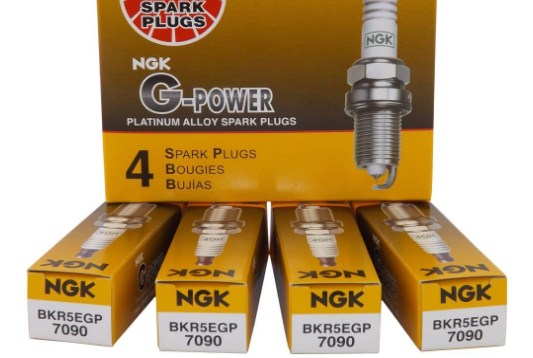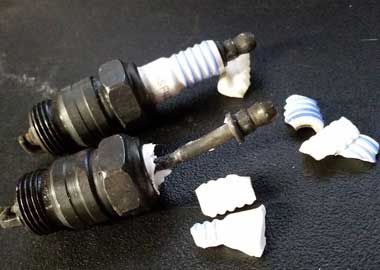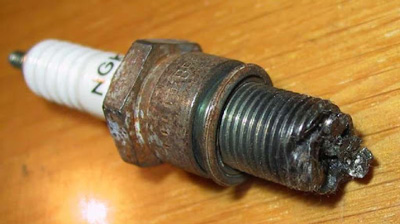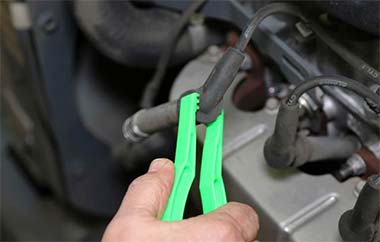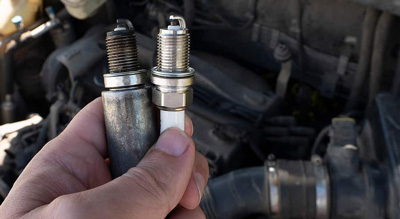9 Best Aftermarket TPMS Sensors for Any Budget & to Enhance Tire Safety
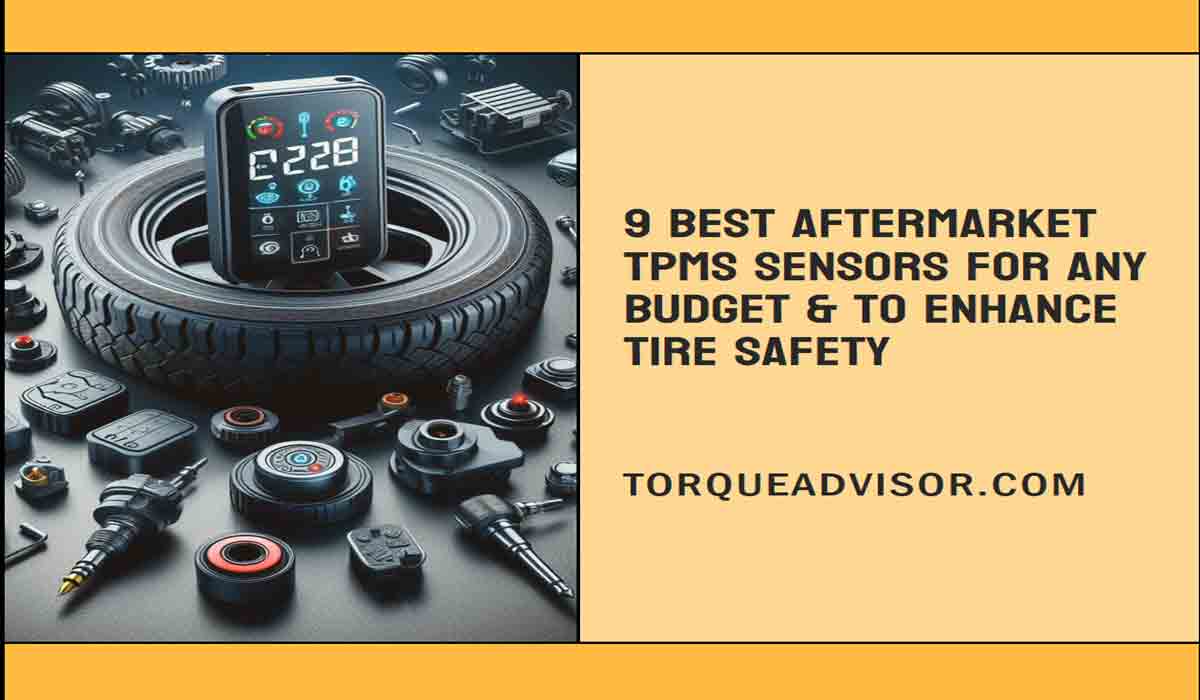
While many vehicles come equipped with built-in TPMS sensors, aftermarket options offer an upgrade or replacement for those looking to enhance their system’s performance or compatibility.
In this guide, we delve into the best aftermarket TPMS sensors available. We will provide aftermarket TPMS reviews to help you make an informed choice.
Best Aftermarket TPMS Sensors for Specific Needs
- Best for RVs: Tymate TPMS for RV
- Best for Smartphone Integration: TireMinder Smart TPMS
- Best for Versatility: Schrader 33500 EZ-Sensor TPMS
- Best for Professionals: Autel MaxiTPMS TS508 TPMS Relearn Tool
- Best for User-friendliness: Jansite Aftermarket TPMS Sensor Kit
9 Best Aftermarket TPMS Sensors 2024
Discover the top-rated aftermarket TPMS sensors for optimal tire pressure monitoring. Our guide highlights the best TPMS sensor brands, features, and reviews to help you make an informed choice for enhanced vehicle safety and performance. Here are some of the best aftermarket TPMS systems and models that are known for their reliability and performance:
TPMS Comparison: Features and Price
| Product | Features | Price |
| TireMinder Smart TPMS | Wireless Monitoring, Smartphone Connectivity, Customizable Alerts | Check Price |
| Schrader 33500 EZ-Sensor TPMS | Multi-Frequency Compatibility, Programmable Design, Future-Proof Technology | Check Price |
| Autel MaxiTPMS TS508 TPMS Relearn Tool | Comprehensive TPMS Services, MX-Sensor Programming, Quick & Advanced Modes | Check Price |
| Tymate TPMS for RV | Real-Time Monitoring, Travel Trailer Compatibility, Instant Leak Detection | Check Price |
| Jansite Aftermarket TPMS Sensor Kit | Adjustable Display, Sensor Data Programming, Versatile Compatibility | Check Price |
| Tymate RV TPMS – M12-3 | Instant Leak Detection, RV Specific Design, Comprehensive Monitoring | Check Price |
| Leepee Motorcycle TPMS | Motorcycle Compatibility, Tire Pressure & Temperature Monitoring | Check Price |
| VESAFE Wireless TPMS for Small Vehicles | Bluetooth Connectivity, Real-Time Monitoring, User-Friendly Features | Check Price |
| GUTA Aftermarket Internal TPMS System | 10 Special Sensors, Accurate Reading, Internal Sensor Design | Check Price |
Read More about Can You Test TPMS Sensors Before Installing: Explained
9 Best Aftermarket TPMS Sensors
1. Tymate Tire Pressure Monitoring System for RV
The Tymate Tire Pressure Monitoring System (TPMS) is a cutting-edge device designed specifically for RV enthusiasts. Its intuitive LCD display and solar charging capability ensure that your RV’s tires remain at optimal pressure, enhancing safety and extending tire lifespan.
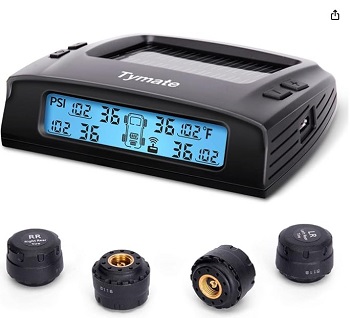
Features
- LCD Display: Provides clear and real-time tire pressure readings, ensuring you are always informed about your RV’s tire conditions.
- Solar Charger: Harnesses the sun’s power to keep the TPMS charged, reducing the need for frequent battery replacements.
- +25% -15% PSI Range: Monitors tire pressure within a broad range, allowing for variations due to temperature changes and ensuring timely alerts.
- Alarm System: Instantly notifies users of any discrepancies or dangerous tire pressures, ensuring immediate attention and action.
Pros
- Enhanced Safety: Real-time monitoring ensures that tire issues are detected promptly, reducing the risk of accidents due to under or over-inflated tires.
- Eco-Friendly: The solar charging feature reduces the carbon footprint by decreasing battery wastage and the need for disposable batteries.
- Extended Tire Lifespan: By maintaining optimal tire pressure, the TPMS helps prevent premature tire wear and tear, saving costs in the long run.
- User-Friendly: The device is easy to set up and use, making it suitable for novice and experienced RV owners.
Cons
- You need a repeater to use it on an RV
2. TireMinder Smart TPMS Review
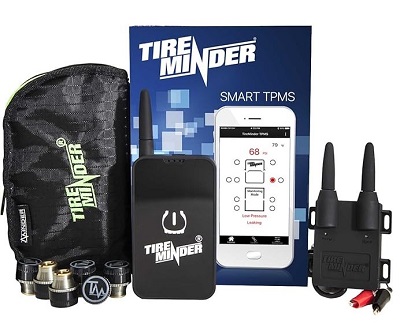
Features:
- Wireless Monitoring: The TireMinder Smart TPMS offers wireless monitoring of tire pressure and temperature, providing real-time data to keep you informed about your RV, Motorhome, 5th Wheel, Motor Coach, or Trailer’s tire status.
- 6 Transmitters: The inclusion of 6 transmitters allows comprehensive monitoring of all tires, promoting safety by providing information on each tire’s condition individually.
- Smartphone Connectivity: The TPMS system connects to your smartphone, allowing you to conveniently check tire data on the go. This feature enhances user accessibility and ease of use.
- Customizable Alerts: Set custom pressure and temperature thresholds, and receive alerts on your smartphone when these thresholds are exceeded. This proactive approach helps prevent potential tire issues before they become serious.
- Easy Installation: The system is designed for easy DIY installation, eliminating the need for professional assistance. Clear instructions and user-friendly setup contribute to a hassle-free experience.
Pros:
- Comprehensive Monitoring: With 6 transmitters, the TireMinder Smart TPMS provides detailed information on each tire, ensuring thorough coverage and safety.
- Real-Time Alerts: Customizable alerts keep you informed in real-time, allowing you to take prompt action in case of any tire-related issues.
- Smartphone Integration: The ability to monitor tire data through a smartphone app adds a layer of convenience, especially during travel.
- User-Friendly Installation: DIY installation is a plus, making it accessible for users who prefer handling installations themselves.
Cons:
- Compatibility Issues: Some users may encounter compatibility issues with certain smartphone models or operating systems, so it’s essential to check compatibility before purchase.
- Learning Curve: While the system is designed for ease of use, there might be a learning curve for users who are new to TPMS technology.
- Battery Life: Depending on usage, the battery life of the transmitters may vary, and replacing batteries could be an ongoing cost.
3. Schrader 33500 EZ-Sensor TPMS Review
The Schrader 33500 EZ-Sensor TPMS is a versatile and future-proofed solution for those seeking a programmable sensor with wide vehicle compatibility. While it requires careful programming and tool maintenance, its features and OEM-quality standards make it a reliable choice for effective tire pressure monitoring.
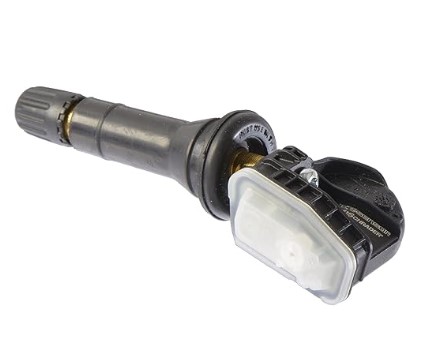
Features and benefit:
- Multi-Frequency Compatibility: The Schrader 33500 EZ-Sensor is a versatile TPMS sensor that covers three frequencies—314.9 MHz, 315 MHz, and 433 MHz—streamlining inventory management and ensuring compatibility with a wide range of vehicles.
- Programmable Design: This TPMS sensor requires programming using a compatible tool, taking into account the vehicle’s year, make, and model protocol. This programmable feature enhances flexibility and adaptability to various vehicles.
- Optimized Inventory Management: By combining multiple frequency applications into one sensor, the EZ-Sensor minimizes inventory levels and reduces the risk of lost sales. This is a practical solution for retailers and auto service centers.
- OEM-Quality Standards: Manufactured to OEM quality standards and requirements, the Schrader EZ-Sensor 33500 replicates OE functionality, including auto-locate technology. This ensures that it meets the high standards set by original equipment manufacturers.
- Future-Proof Technology: The sensor is designed to be future-proofed, meaning it can support new and pending OE system technologies. This feature helps extend the lifespan of the sensor, making it a reliable and forward-thinking choice.
- Valve Core Torque: The Schrader 33500 EZ-Sensor has a valve core torque of 3.5 in-lbs, providing the right balance of tightness to secure the sensor in place without causing damage.
Pros:
- Versatility: The ability to cover multiple frequency applications in one sensor enhances convenience for users and reduces the complexity of inventory management.
- Flexibility through Programming: The programmable nature of the EZ-Sensor allows for compatibility with a wide range of vehicles, making it a versatile choice for different makes and models.
- Inventory Optimization: The consolidation of frequencies optimizes inventory levels, making it an efficient choice for businesses dealing with TPMS sensors.
- OEM-Quality Replication: Meeting OEM quality standards ensures that the sensor functions reliably and accurately, replicating the performance of original equipment.
- Future-Proofing: The sensor’s capability to support new and pending OE system technologies adds value by ensuring continued compatibility with evolving automotive technologies.
Cons:
- Programming Required: The need for programming before installation may be considered a drawback for users who prefer a more straightforward, plug-and-play solution.
- Tool Dependency: Users need a compatible programming tool to set up the sensor, which adds an extra step to the installation process.
- Software Updates: Regular updates are required for the TPMS scan and programming tool software to ensure maximum vehicle coverage, potentially causing inconvenience if overlooked.
What is a Schrader EZ sensor?
The Schrader EZ Sensor is a programmable TPMS sensor designed for various vehicles. It consolidates multiple frequency applications into one, simplifying inventory and increasing compatibility.
How do you program a Schrader EZ sensor?
To program a Schrader EZ sensor, use a compatible TPMS programming tool. Input the vehicle’s year, make, and model protocol before installation and relearn procedures.
What is the inventory benefit of the Schrader EZ Sensor Part Number 33500?
The Schrader EZ Sensor Part Number 33500 streamlines inventory management by combining 314.9 MHz, 315 MHz, and 433 MHz applications into one sensor, reducing complexity and costs.
Who makes Schrader TPMS?
Schrader TPMS is made by Schrader International, a leading global manufacturer of tire pressure monitoring system sensors. Their sensors are known for their quality and reliability.
4. Autel MaxiTPMS TS508 TPMS
The Autel MaxiTPMS TS508 TPMS Relearn Tool stands out for its comprehensive features, user-friendly programming, and lifetime updates,cost-effective programming, two operation modes, wireless sensor activation making it a valuable investment for individuals and professionals seeking effective TPMS solutions.
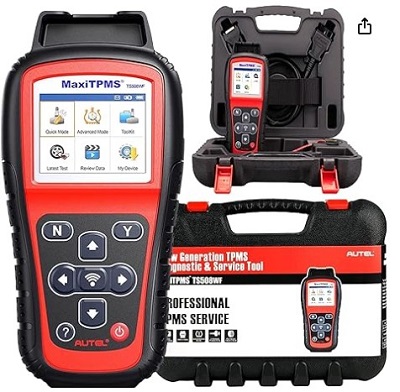
Features:
- Comprehensive TPMS Services: The Autel MaxiTPMS TS508 offers a range of TPMS services, including a one-click TPMS health check, reading and clearing TPMS DTCs, on-screen DTC descriptions, resetting TPMS warning lights, and activating/relearning both OE and aftermarket TPMS sensors.
- Program Autel MX-Sensors: This tool allows car enthusiasts to easily program sensor data to Autel MX-Sensors (315/433MHz), providing a cost-effective alternative to dealership visits.
- Multiple Programming Options: The TS508 supports four programming options, including Copy By Activation, Copy By Manual Input, Auto Create, and Copy by OBD (not available with TS408). This flexibility allows users to replace faulty sensors with low battery life or malfunctioning sensors.
- Quick Mode & Advanced Mode: With two operation modes, the TPMS Quick Mode provides basic functions for quick sensor checks and MX-Sensor programming, while the Advanced Mode offers complete TPMS functions, including sensor checks, TPMS diagnosis, MX-Sensor programming, and sensor position relearn.
- Activate & Relearn All Known Sensors: The TS508 can wirelessly activate all OEM/Universal TPMS sensors, retrieving essential sensor data such as Sensor ID, Tire Pressure, Tire Temperature, Sensor Battery, Sensor Position, and Frequency. It supports three relearn methods: Stationary Relearn, Automatic Relearn, and Relearn by OBD (not supported by TS408).
- Lifetime Free Updates & 1 Year Warranty: Users benefit from lifetime free software updates, ensuring the tool stays up-to-date with evolving TPMS technologies. Autel offers a generous 1-year warranty, along with lifetime real-time tech support and a 30-day money-back or new replacement policy.
- Data Review & Printing: The TS508 supports data review and printing functions, allowing users to analyze, repair, or share reports instantly. This feature enhances the tool’s utility for professionals and DIY enthusiasts alike.
Pros:
- Cost-Effective Programming: The ability to program sensor data to Autel MX-Sensors at home saves users money and eliminates the need for dealership visits.
- Two Operation Modes: Quick Mode and Advanced Mode offer flexibility for users with varying needs, from basic sensor checks to advanced TPMS diagnostics.
- Wireless Sensor Activation: The tool can wirelessly activate all known OEM/Universal TPMS sensors, streamlining the retrieval of crucial sensor data.
- Lifetime Free Updates: Lifetime free software updates ensure that the tool remains compatible with the latest TPMS technologies, offering long-term value.
- Data Review & Printing: The ability to review and print data enhances the tool’s functionality for in-depth analysis and reporting.
Cons:
- Programming Tool Dependency: Users need a compatible programming tool for sensor setup, which may be seen as an additional step in the process.
- OBD Relearn Not Supported by TS408: The OBD relearn option is not available with the TS408 model, limiting relearn options for users with this specific tool.
Read Also Can TPMS Cause Check Engine Light? Diagnosis And Fix
Can Autel TS508 program aftermarket sensors?
Autel TS508 can program Autel MX-Sensors, both OE and aftermarket. It supports multiple programming options for versatility in sensor compatibility.
What is the difference between TS508 and TS508WF?
The TS508WF variant has Wi-Fi connectivity, allowing for easier updates and data sharing. The core functions remain the same between TS508 and TS508WF.
Can Autel program any TPMS sensors?
Autel tools like the TS508 can program Autel MX-Sensors and support various TPMS sensors. However, compatibility may vary based on sensor types and brands.
How do you fix a duplicate TPMS sensor?
To fix a duplicate TPMS sensor, identify the duplicated ID, reprogram the sensor with a unique ID using a TPMS tool, and perform a relearn procedure.
Can Autel sensors be reprogrammed?
Autel sensors, especially Autel MX-Sensors, can be reprogrammed using Autel TPMS tools like the TS508. This flexibility allows for sensor adjustments and replacements.
What TPMS tool can program all sensors?
Autel TS508, among other Autel TPMS tools, is known for programming a wide range of sensors, offering versatility for OE and aftermarket sensor programming needs.
5. Jansite Aftermarket TPMS Sensor Kit
The Jansite Aftermarket TPMS (Tire Pressure Monitoring System) Sensor Kit is a cutting-edge solution designed to ensure optimal tire performance and safety. Its sleek, adjustable display, waterproof design, and real-time monitoring capabilities and straightforward installation make it a must-have for any vehicle owner looking to enhance their driving experience.
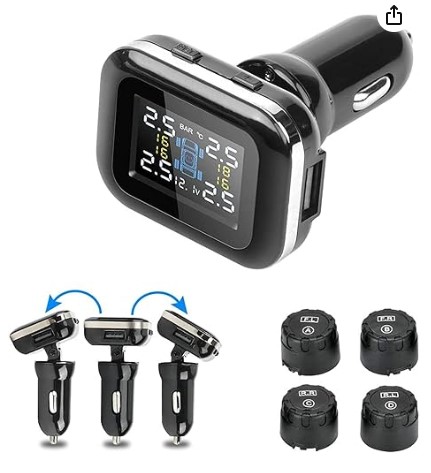
Features
- Waterproof Design: Built to withstand various weather conditions, ensuring longevity and reliable performance.
- Adjustable Display: Allows users to customize the display settings for optimal visibility and convenience.
- Easy Installation: Designed for hassle-free setup, making it suitable for both DIY enthusiasts and professionals.
- Four Sensors Included: Monitors all four tires simultaneously, providing comprehensive coverage.
- Real-time Monitoring: Offers instantaneous updates on tire pressure and temperature, enhancing safety on the road.
- USB Connectivity: Easily connect and update the system using a standard USB interface.
- Wireless Transmission: Eliminates the need for cumbersome cables, ensuring a tidy and efficient setup.
Pros
- Enhanced Safety
- User-Friendly
- Comprehensive Coverage
- Waterproof design and high-quality materials ensure long-lasting performance.
- USB connectivity allows for easy system enhancements.
Cons
- The sensors may require occasional battery replacements or recharging.
6. Tymate RV TPMS – M12-3
The Tymate RV TPMS – M12-3 is a Tire Pressure Monitoring System designed specifically for recreational vehicles (RVs). It offers real-time monitoring of tire pressures and temperatures, ensuring safer and more efficient travel for RV enthusiasts.
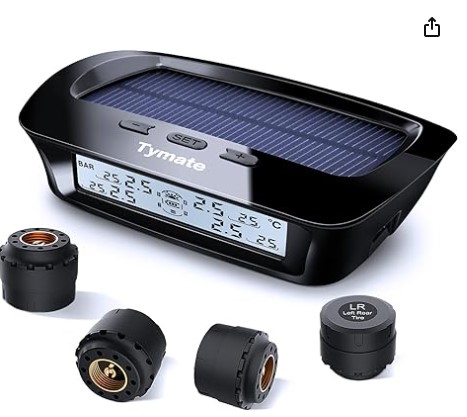
Features
- Wireless Monitoring: The system provides wireless monitoring of up to 12 tires, including the spare.
- High-Resolution Display: A clear and high-resolution LCD display provides real-time data on tire pressures and temperatures.
- Fast Leak Alert: Instantly detects slow and fast leaks, notifying the driver immediately.
- Anti-theft Design: Sensors are designed to prevent theft and ensure durability in all weather conditions.
- User-Friendly Interface: Easy-to-navigate interface with intuitive controls for quick setup and monitoring.
Pros
- Reducing the risk of blowouts and accidents.
- Saving on fuel costs during long journeys.
- The sensors have a long-lasting battery life, reducing the frequency of replacements.
- Suitable for a wide range of RVs, trailers, and campers.
- Provides peace of mind to drivers by offering real-time data on tire conditions.
Cons
- Regular maintenance and occasional battery replacements for the sensors might be required.
7. Leepee Motorcycle TPMS
The Leepee Motorcycle TPMS is a cutting-edge tire pressure monitoring system designed specifically for motorcycle enthusiasts. Engineered to cater to diverse weather conditions, from scorching summer rides to chilly winter adventures, this system promises to enhance safety and prolong tire lifespan.
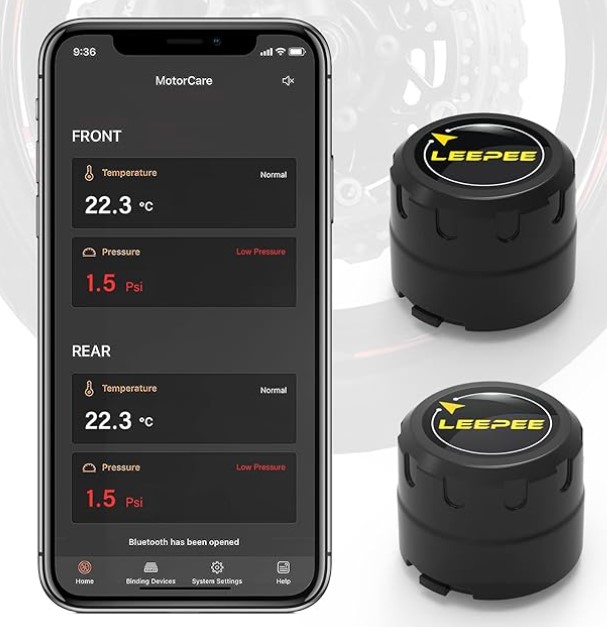
Features
- Bluetooth 5.0 Connectivity: Seamless and stable connection with your iOS device for instant data transmission.
- Temperature Alarm: Alerts riders of any unsafe temperature levels, ensuring optimal tire performance and safety.
- All-Weather Performance: Designed to operate efficiently in all weather conditions, from extreme heat to freezing cold.
- Battery Alarm: Notifies users when the TPMS battery is running low, ensuring uninterrupted monitoring.
- Automatic Sleep Mode: Conserves battery life by automatically going into sleep mode when not in use, while instantly waking up when movement is detected.
Pros
- Real-time monitoring ensures that riders are immediately informed of any tire issues
- The system helps prolong the lifespan of motorcycle tires, saving costs in the long run.
- Easy setup and integration with iOS devices make it accessible
- Its ability to function in diverse weather conditions makes it a reliable companion for year-round riding.
- The automatic sleep mode and battery alerts ensure that the device remains operational for extended periods without frequent recharging.
Cons
- Some users might find the initial pairing and setup process with their devices a bit challenging.
8. VESAFE Wireless TPMS for Small Vehicles
The VESAFE Wireless TPMS (Tire Pressure Monitoring System) is meticulously designed for small vehicles, ensuring optimal tire safety and performance. Its wireless design ensures easy installation and minimal interference with vehicle aesthetics.
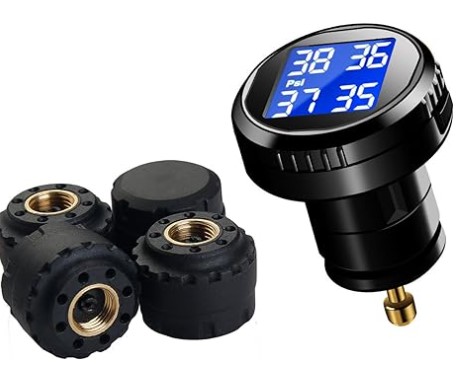
Features
- Wireless Connectivity: No need for complex wiring; the system operates wirelessly, ensuring a neat installation without clutter.
- Real-time Monitoring: Constantly monitors tire pressure and temperature, offering instant alerts for any anomalies.
- User-friendly Interface: Intuitive display and controls allow for easy navigation and quick access to vital information.
- Compact Design: Specifically tailored for small vehicles, ensuring a seamless fit and minimal intrusion.
- Battery-powered Sensors: Long-lasting sensors with replaceable batteries, offering a hassle-free maintenance experience.
Pros
- Immediate alerts for low or high tire pressure prevent potential blowouts and accidents.
- Properly inflated tires can improve fuel efficiency
- Prolong the lifespan of tires, reducing replacement costs.
- Installation is straightforward and doesn’t require professional help.
- Suitable for various small vehicles
Cons
- In rare cases, users might experience signal interference.
9. GUTA Aftermarket Internal TPMS System
The GUTA Aftermarket Internal TPMS (Tire Pressure Monitoring System) is a cutting-edge solution designed to ensure optimal tire performance and safety. Engineered with advanced technology, this system offers comprehensive monitoring of tire conditions, delivering real-time data to drivers, thus enhancing vehicle safety and efficiency.
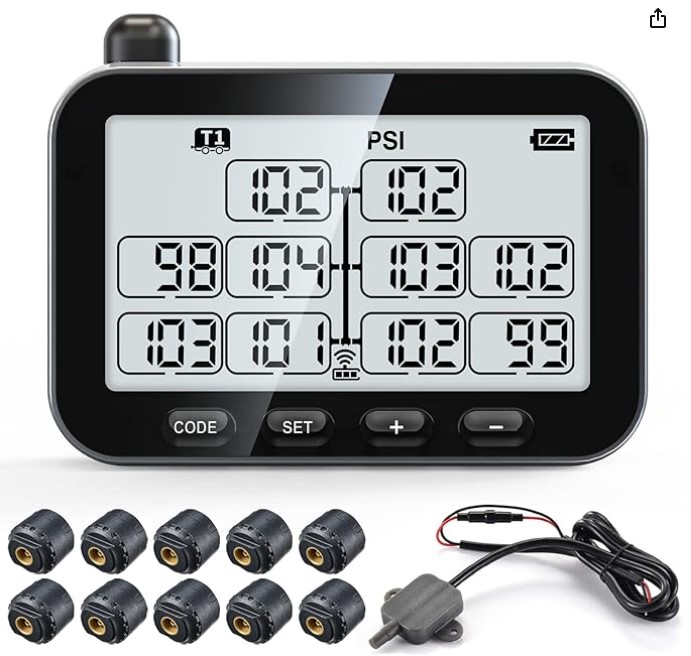
Features
- Comprehensive Sensor Range: Equipped with 10 high-sensitivity sensors, the system provides accurate monitoring for each tire, ensuring uniformity and reliability.
- High-Temperature Resistance: Capable of withstanding temperatures up to 185 ℉, ensuring consistent performance in various driving conditions.
- Electromagnetic Interference Shielding: Designed with advanced shielding mechanisms to mitigate electromagnetic interference, ensuring uninterrupted data transmission.
- Long-Distance Monitoring: Offers extended range capabilities, enabling monitoring even in large vehicles or trailers.
- Quick Charging: The system’s advanced battery technology allows for a fast 4-hour charging time.
- Extended Lifespan: With a durable build and efficient design, the TPMS system boasts a lifespan of up to 4 years.
Pros
- Reducing the risk of accidents due to tire-related issues.
- By ensuring proper tire inflation, the system promotes fuel efficiency, saving on operational costs.
- Intuitive interface and easy installation
- With a lifespan of 4 years and minimal maintenance requirements, it offers long-term value and savings.
Cons
- The need for a 4-hour charging period could potentially cause downtime for some users.
Best Aftermarket TPMS Sensor For 2009 Dodge Calibre
The Jsueng TPMS Sensor is specifically designed for Chrysler, Dodge, Ram, and Jeep vehicles. Operating at 315MHz, these sensors ensure accurate tire pressure monitoring.
Direct replacements for part numbers 56029479AA and 56029479AB, guarantee optimal performance and compatibility, enhancing vehicle safety and tire longevity.
Best Aftermarket TPMS Sensor For 2009dodge Calibre
The CDWTPS TPMS Sensor operates at 433MHz, compatible with 2006-2010 Chrysler and Dodge vehicles. This tire pressure monitoring system sensor ensures accurate tire pressure readings, enhancing safety and performance. Designed for reliability, it seamlessly integrates with the vehicle’s system, alerting drivers to potential tire issues promptly.
Best Aftermarket TPMS Sensors Subaru
The SUBARU 28103AJ00A TPMS (Tire Pressure Monitoring System) is a component designed to monitor the air pressure inside the tires of a vehicle. It provides real-time data to the driver, ensuring optimal tire inflation for safety and performance. This system helps prevent tire-related accidents and enhances the overall driving experience.
Internal vs. External Sensors:
Internal sensors: These are mounted inside the tire and are more tamper-proof, but they also require professional installation and are more expensive.
External sensors: These are mounted on the valve stem and are easier to install yourself, but they are also more likely to be damaged.
Frequency:
- 315MHz: This is the most common frequency for TPMS sensors, but it may not be compatible with all vehicles.
- 433MHz: This is another common frequency for TPMS sensors, and it is often used in European vehicles.
Programmability:
- Pre-programmed sensors: These sensors are already programmed to work with your specific vehicle, so you don’t need to do anything special to install them.
- Universal sensors: These sensors can be programmed to work with a variety of vehicles, but you will need to use a TPMS tool to program them.
What are the 2 types of TPMS systems?
There are two main types of TPMS (Tire Pressure Monitoring System) systems:
Direct TPMS (dTPMS): This system uses sensors installed inside each tire to directly monitor the tire pressure. These sensors provide real-time data on individual tire pressures, and if a significant drop in pressure is detected, it triggers a warning to the driver.
Indirect TPMS (iTPMS): This system does not use individual tire sensors. Instead, it relies on the vehicle’s existing ABS (Anti-lock Braking System) and ESP (Electronic Stability Program) sensors to indirectly monitor tire pressure. iTPMS systems compare the rotational speeds of the tires, and if an underinflated tire is detected (resulting in a smaller tire diameter), it may trigger a warning.
Can I Swap TPMS Sensors?
Yes, Tire Pressure Monitoring System (TPMS) sensors can be swapped. However, it’s essential to ensure compatibility with your vehicle’s make, model, and year. After swapping, you may need to reprogram or recalibrate the sensors to ensure accurate tire pressure readings and to prevent dashboard warning lights from illuminating.
What Is The Difference Between OEM and Aftermarket TPMS Sensors?
OEM TPMS (Tire Pressure Monitoring System) sensors are designed for specific vehicle models, often last longer, boast a 1 in 1 million fail rate, and come with a warranty. Aftermarket TPMS sensors are generally cheaper and sometimes come pre-loaded, but they may not have the same level of quality or reliability as OEM counterparts.
Here’s a table outlining the key differences between OEM (Original Equipment Manufacturer) and Aftermarket TPMS (Tire Pressure Monitoring System) sensors:
| Aspect | OEM TPMS Sensors | Aftermarket TPMS Sensors |
| Source | Manufactured by the vehicle’s original equipment manufacturer. | Produced by third-party companies not associated with the vehicle’s original manufacturer. |
| Compatibility | Specifically designed for the make and model of a particular vehicle. | Designed to be compatible with a wide range of vehicles, offering broader application. |
| Price | Typically more expensive due to being genuine parts from the vehicle manufacturer. | Generally more cost-effective as they are produced by various manufacturers for multiple applications. |
| Availability | Available through authorized dealerships and specific OEM parts distributors. | Widely available through various automotive retailers, online stores, and aftermarket parts suppliers. |
| Features | Often equipped with features specific to the vehicle, such as auto-locate technology. | May have a range of features but might not replicate all OEM functionalities. |
| Programming | May come pre-programmed for specific vehicles, requiring minimal or no programming during installation. | Usually requires programming to match the vehicle’s specifications, often done using a TPMS programming tool. |
| Warranty | Typically comes with a warranty directly from the vehicle manufacturer. | Warranty terms vary and are provided by the aftermarket manufacturer or distributor. |
Read Also Best TPMS Programming Tool For Toyota : A Detailed Guide
What Is The Difference Between 315mhz And 433mhz TPMS?
Here are some key differences between the two:
1. Frequency
- 315MHz: This frequency is more common in the Americas, including the United States and Canada.
- 433MHz: This frequency is more common in Europe and many other parts of the world.
2. Range and Penetration
Generally, lower frequencies (like 315MHz) tend to have better range and penetration through obstacles compared to higher frequencies (like 433MHz).
3. Interference
The likelihood of interference from other devices or systems might vary between the two frequencies depending on the specific environment and regional usage patterns.
4. Compatibility
If a vehicle is equipped with TPMS sensors operating at one frequency (e.g., 315MHz), a TPMS tool or system that operates at the same frequency is typically required to communicate with and service those sensors.
5. Can You Use Different Brand TPMS Sensors?
Using different brand TPMS (Tire Pressure Monitoring System) sensors can lead to compatibility issues. It’s essential to ensure that the sensors are compatible with your vehicle’s system. Mismatched sensors might not function correctly or could provide inaccurate readings, compromising safety and performance.
6. How Do I Choose The Right TPMS Sensor?
Here’s a step-by-step guide to help you choose the right TPMS sensor:
- Direct vs. Indirect TPMS
Direct TPMS sensors measure the actual pressure inside each tire and transmit this information to the vehicle’s onboard computer. Indirect TPMS relies on the vehicle’s anti-lock brake system (ABS) to monitor tire speed and detect differences in tire diameters, which can indicate low tire pressure.
- Sensor Compatibility
If you’re replacing a TPMS sensor, ensure the replacement is compatible with your vehicle’s make, model, and year.
- Frequency & Protocol
TPMS sensors operate on specific frequencies and protocols to communicate with the vehicle’s onboard computer. Ensure the sensor you’re considering matches your vehicle’s specifications.
- Sensor Quality & Reliability
Opt for sensors from reputable brands known for quality and reliability. Cheap or unknown brands might not offer accurate readings or may fail prematurely.
- Battery Life
Check the expected battery life of the TPMS sensor. Some sensors have longer-lasting batteries than others.
- Ease of Installation
Some TPMS sensors are designed for easy DIY installation, while others might require professional installation or calibration.
- Cost Consideration
While it’s essential to consider your budget. Investing in a good TPMS sensor can offer better performance and longevity.
- Warranty & Support
Check if the TPMS sensor comes with a warranty. A good warranty can provide peace of mind and assurance of the product’s quality.
FAQs
What are the common issues with TPMS sensors?
Common TPMS sensor issues include battery failure, sensor damage, and inaccurate readings. Regular maintenance and proper installation can mitigate these issues.
How often should TPMS sensors be replaced?
TPMS sensors generally last 5 to 10 years. Replacement frequency depends on usage conditions and sensor lifespan. Regular checks and timely replacements enhance safety.
Are aftermarket TPMS sensors reliable?
Aftermarket TPMS sensors vary in reliability. Choosing reputable brands and ensuring compatibility with the vehicle are crucial for optimal performance.
Can I use TPMS sensors from one vehicle on another?
Using TPMS sensors from one vehicle on another may lead to compatibility issues. Sensors should match the vehicle’s specifications for accurate readings.
What is the cost of TPMS sensor replacement?
TPMS sensor replacement costs vary, ranging from $50 to $100 per sensor, excluding labor. Prices depend on the brand and features of the sensor.
Do TPMS sensors need recalibration after tire rotation?
Yes, TPMS sensors may need recalibration after tire rotation to ensure accurate pressure readings. Consult the vehicle’s manual or a professional for proper recalibration procedures.
Who makes the best TPMS sensors
Determining the “best” TPMS sensors often depends on specific needs and preferences. However, TireMinder, Tymate, and Vesafe are reputable brands known for producing quality TPMS sensors in the market.
What are the 3 methods of programming a TPMS sensor?
Methods of Programming a TPMS Sensor:
- Manual Input: The sensor information is manually input into the TPMS tool, which then transfers the data to the vehicle’s ECU.
- OBD (On-Board Diagnostics) Programming: The TPMS tool communicates with the vehicle’s OBD port to program sensor data.
- Activation Programming: The new sensor is activated by the TPMS tool, allowing it to learn the vehicle’s sensor IDs.
What is the biggest benefit of the TPMS?
Biggest Benefit of TPMS: The primary benefit of TPMS is enhanced safety. It provides real-time monitoring of tire pressure, alerting drivers to underinflated tires, reducing the risk of blowouts, accidents, and improving overall vehicle handling.
What is TPMS diagnostic tool?
TPMS Diagnostic Tool: A TPMS diagnostic tool is a device used to monitor, diagnose, and program TPMS sensors. It can read sensor data, clear diagnostic trouble codes, program new sensors, and perform system diagnostics.
How does TPMS work without battery?
TPMS Working Without Battery: Some TPMS sensors use passive RFID (Radio-Frequency Identification) technology, which doesn’t require a battery. Instead, these sensors harvest energy from the radio signals sent by the TPMS system. While they have a limited range, they eliminate the need for battery replacement.
Can TPMS be installed aftermarket?
Yes, Tire Pressure Monitoring Systems (TPMS) can be installed aftermarket. There are various aftermarket TPMS kits available that can be installed on vehicles that didn’t originally come equipped with TPMS.
Do aftermarket TPMS sensors need to be programmed?
Yes, aftermarket TPMS (Tire Pressure Monitoring System) sensors typically need to be programmed to communicate with a vehicle’s onboard system and accurately monitor tire pressures.
Are aftermarket TPMS sensors universal?
No, aftermarket TPMS (Tire Pressure Monitoring System) sensors are not universal. They vary by make, model, and year of vehicle. Compatibility must be checked before installation.
Are TPMS sensors brand specific?
No, Tire Pressure Monitoring System (TPMS) sensors are not inherently brand-specific. However, compatibility with specific vehicles and systems may vary, requiring appropriate programming or calibration.
Can you use a tymate TPMs on a trailer?
Yes, Tymate TPMs can be used on a trailer to monitor tire pressures and temperatures for enhanced safety and performance.
How long do aftermarket TPMS sensors last?
Aftermarket TPMS sensors typically last between 5 to 10 years, depending on usage conditions and battery life. Regular maintenance and replacement can help ensure optimal performance and safety.
How much does it cost to replace tire pressure monitoring system sensors?
Replacing tire pressure monitoring system (TPMS) sensors typically costs between $50 to $200 per tire. Prices can vary based on the vehicle make, model, and the specific TPMS sensor required.
Conclusion
Aftermarket TPMS sensors vary in quality and compatibility. However, brands like VDO, Schrader, and ATEQ are the best aftermarket tpms sensors for their reliability and accuracy. It’s crucial to ensure compatibility with your vehicle model. Always prioritize safety and performance over cost when selecting the best TPMS sensors for your needs.

